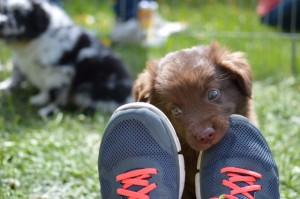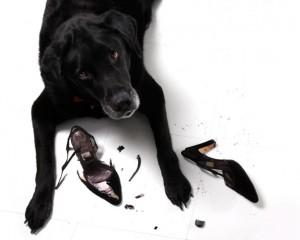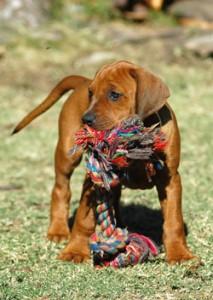
Most dogs have a huge desire to chew. Many people picture puppies with their sharp teeth exploring their surroundings through chewing, but after even after a puppy’s adult teeth erupt, they will continue to chew and may even be quite destructive chewers for the first 2 years. Many dogs chew as a relaxing pastime and before they fall asleep.
Here are some ideas that may help you keep your puppy/dog and house safe from injury:
- Assume that your puppy and young dog will chew things when left unattended
- Plan for this by having a safe area for your dog to rest, such as a crate, kennel or room barricaded by a baby gate
- Bitter apple spray can be applied several times a day to a table leg or other inappropriate item that it is starting to gnaw on
- Close doors to deny access to forbidden items
- Nothing is completely safe, but you will still need to provide them with options to chew
- Supervise your pup with new toys
- Dogs prefer different textures at different life stages
- Experiment with different textures and observe the chewing habits of your dog to determine which toys are safest for it.
- Select a toy that can’t be swallowed or break off into small pieces
- Never allow your dog to play with/chew old articles of clothing or shoes, as it may think that means that even your new clothes and shoes are fair game!
- Have a variety of options ready for your dog at a moment’s notice
- Consider raw vegetables, such as carrots or celery
- Toys with food compartments can provide mental stimulation
- Assume that your puppy/young dog will chew anything left in the crate
- Don’t leave it unsupervised with a blanket in the crate until you have tested this for short periods while you are home
- Sometimes chews that are extra-hard and marketed as indestructible may actually cause more damage to your dog
- Such super-hard items may result in broken teeth when they are chewed on
- Offering your dog bones to chew can be risky
- Throw away a toy as soon as it is damaged, so that it can’t cause injury to your dog
- There are occasional reports of trauma to the underlying dental (alveolar) bone of dogs with punctured gums from broken toys
- Certain toys are best left for play time with their favourite person – you!
The really neat thing is that we see mature dogs that still have their soft stuffed toys in one piece; on the other end of the spectrum, we see dogs that chew through the “indestructible” variety of toys in one session. Dogs have individual tastes and they will show you their preferences in chew toys.
If you are finding that your dog’s chewing seems to be excessive and uncontrolled, perhaps your dog needs another outlet for its pent-up energy/boredom/anxiety. Here are some non-chewing suggestions for your pooch: http://www.pethealthnetwork.com/dog-health/dog-behavior/benefits-tired-dog.
If you have any questions talk to our team members at Coventry Animal Hospital.



